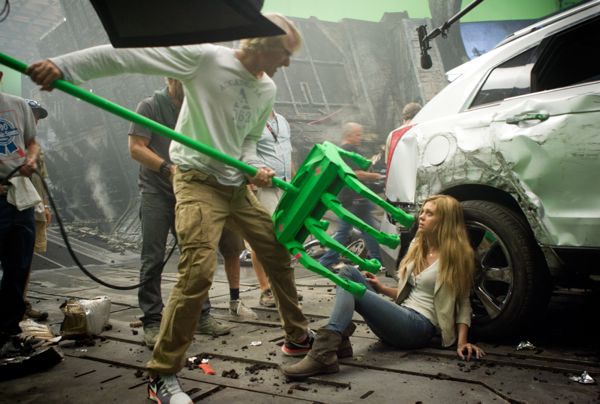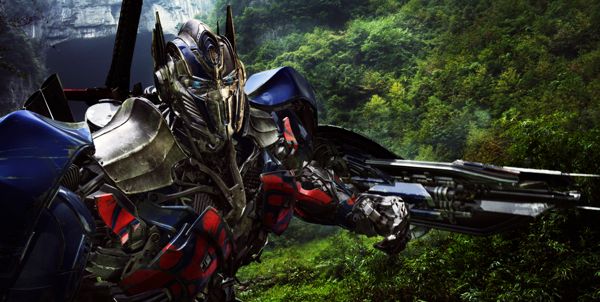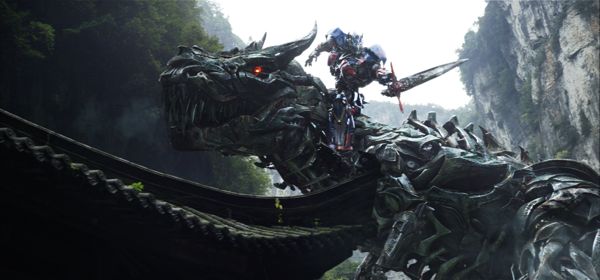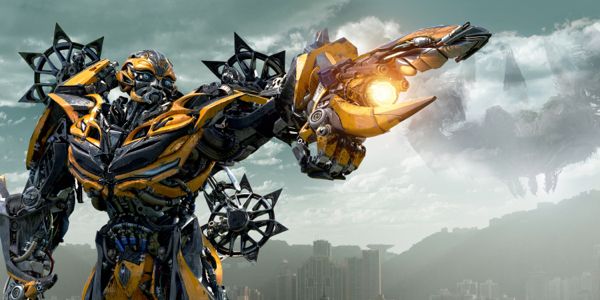Behind the Scenes on Visual Effects For ‘Transformers 4’: Creating the DinoBots
- Details
- Category: Interviews
- Created: Tuesday, 24 June 2014 13:18
- Published: Tuesday, 24 June 2014 15:49
- Written by Lupe R Haas

Michael Bay’s special effects team at ILM were hard at work bringing the revamped Transformers to life once again, and we’re talking to ILM’s Visual Effects Supervisor Patrick Tubach about going back to the drawing board and creating the DinoBots for TRANSFORMERS: AGE OF EXTINCTION.
Despite the love/hate relationship with the Transformers franchise, everyone can agree the visual effects are always top notch. We can thank the team at Industrial Light & Magic (ILM) for creating photorealistic scenes between the human characters and the alien robots. ILM’s Visual Effects Supervisor Patrick Tubach takes us behind the scenes on recreating the Transformers and starting from scratch in creating the new robot cast – the DinoBots. He’s not new to the franchise with AGE OF EXTINCTION being the third time working on the Michael Bay movie.
Q: What did you specifically do for this movie?
A: For this one I was the associate visual effects supervisor. So, I guess you can think about it, I was the sort of right hand man to visual effects supervisor and I helped do all the things that the effects chief does. But being such and epically large movie kind of helping be his proxy for when he is doing other things and I am trying to split the work with him and get things through ILM.
Q: This the fourth film in Transformers franchise. Is there a template that you can refer back to when working on a new Transformers movie for the returning characters? Or do you start from scratch every time?
A: Well, Transformers is an interesting franchise because there is the certain familiarity with… we have certainly been through this before. We have taken our work with the various robots that Michael has designed with his writing team and then our team and then we kind of take them to the next level here at ILM by fleshing them out and making them real CG walking, talking characters. But there really isn’t a sort of, well now that we have done it once we can just do it again and just plug it formula, for all this because the technology keeps getting better and the expectation level keeps going up. So there is no way he is going to be satisfied with Transformers one style robots. It’s got to go through the process of trying to make them bigger and better. You know, getting better facial animation every time and trying to make the characters more real just in texture and writing, in every conceivable way. So, while there is some familiarity there it isn’t like a slam dunk of being to plug into place from one movie to the other.
Q: How has new technology changed the way you work? Has it made it easier or improved digital effects?
A: Well, that’s the interesting thing about technology, I guess, it’s not easy to say that it makes it easier. What it does it expands your ability to do more, which means that you do get to do more. It is, in some ways, it raises the bar for what the audience and filmmakers expect you to be able to do. So, what we hope to do is to make visual effects more about the artistry of it and less about the technical complications of it.
It’s impressive when you stop and think about how long it takes to render Optimus Prime right? But, at the same time, for the audience member that doesn’t really mean anything. They want to be able to see the visual difference on the screen. I think, in this movie, the visual difference is going to be the epic scale of everything.
It’s seeing the density and layers of all the stuff we are putting in the frames, along with robots that have complete and fully fleshed out personalities. That’s something that gets better every time. That’s where the technology sort of takes us into this realm of being able to really feel that every time you sit down and watch the next Transformers movie you are going to feel that it is as modern as any visual effects driven picture you are going to see. As Michael told me when we started, we have made a ton of improvements since Trans one, so you know, you want to know for sure that this is the next step in the next evolution.
Q: Now was it challenging working on the Dinobots because, obviously, you have a different type of movement there?
A: The Dinobots were definitely a challenge. The thing that is different about them is that you can’t rely on the fact that, they’re not going to… They’re as much animal, I guess, as they are character. Where as, with the regular Transformers, we can kind of relate them to human characters and they get their personality sort more from the humanity of that aspect of it. Sometimes you do relate to an actor who is playing the part. Or you can relate to just someone who has that some sort of mannerism. In the case of a Dinobot you are looking at animal characteristics, you are taking kind of a different tack with that because… And they do have, I think, very distinct, amongst all of them, very distinct animal characteristics that we’ve managed to kind of put in there so that when they’re doing their thing on screen you are very aware of who you’re watching. We were very concerned, we didn’t want it to become a confused mishmash, you know, just these Dinobots stomping around and you can’t tell who is who and you can’t tell that they all kind of have their own personalities. That was definitely a challenge.
Q: Do you go on set to make sure the execution is correct?
A: I do. I did not for this particular movie. I came on later so I was only involved in the post-production process on this one.
Q: In your experience is it important for somebody to be on the set to be sure that technically everything looks good for post production?
A: Yeah. Absolutely. I think there’s two main aspects to why ILM always wants a presence on set when we do this stuff. We have our technical team and we have our sort of, I guess, matching team is the best way to put it or data wranglers, you know. Those guys know how these movies go and they’re very, very good about getting us all the data we need in order to fit...
The hard part is you’ve got to fit the Transformers in the frame with humans. So, if you don’t shoot it correctly you’re never going to have a good frame to look at. You are not going to be able to have a conversation between an Optimus Prime and a Mark Wahlberg. And you’re not going to be able to have the action that you want at the end of the day.
Everyone on the production is very aware that ILM needs to be able to sort of help, you know, not dictate but help make suggestions that’s going to help us at the end of the day to make the frames work. Then you have the aspect of just needing to know what was going on. With stuff for our visual effects supervisor who was out there for the shoot, he just needs to know what Michael’s intention is and his thought process is.
Because, before we get into actually get into creating these Dinobots and these Transformers there isn’t much there. You have to have a real vision for that, and Michael (Bay) has that, and Scott needs to get in his head and understand that, hey when we were shooting this the intention was… we were going to do this sort of shot and this was what we hoped to see here. Without that knowledge we would really be behind the curve when we got back to do the work.

Q: From the get-go, the live action against the digital effects is so amazing in these movies. You’re lost in that reality. What do you think is the secret to ILM because there are still some movies that don’t do it as well. You can tell when it’s digital effects. So, what’s the secret?
A: Well, I think the secret is absolutely, you know, it really comes down to people. The best advantage that we have is that ILM has such a reputation amongst even the industry professionals that we attract the best of the best sort of talent. And the people here just really understand how to make something look photographic. It really comes down to just people having a really good eye. And there’s no acceptance and settle for anything. Michael pushes that on us and we push that on ourselves. We do not put something out there that we do not believe in. That comes through in all these movies, it’s been the case where, like you said, you look at their stuff and you cannot tell it’s not total real. That’s something that we aspire to every time we go out and take a shot. That’s just part of the aesthetic here.
Q: How involved is Michael Bay? Is he there a lot?
A: Oh, yeah. He’s here a lot and we teleconference with him all the time, sometimes daily. So, he’s super involved. And he’s a very visual director and a very visual artist. So, he’s very involved in everything we do.
TRANSFORMERS: AGE OF EXTINCTION is in movie theaters June 27, 2014.


